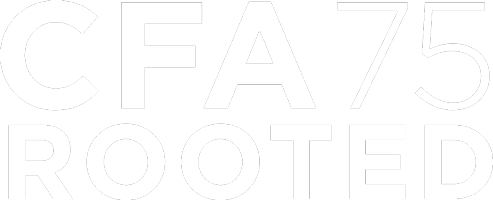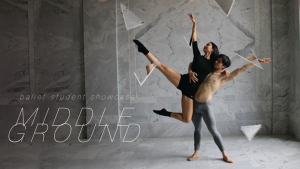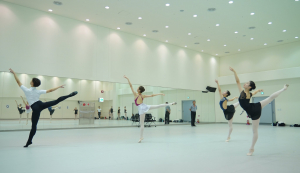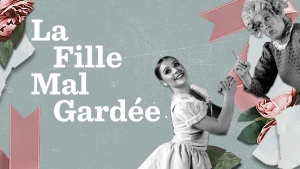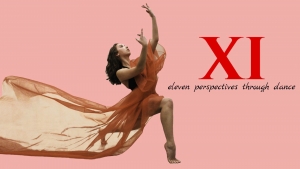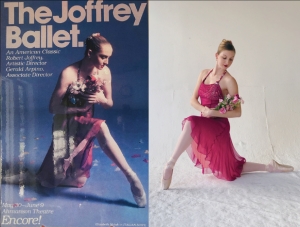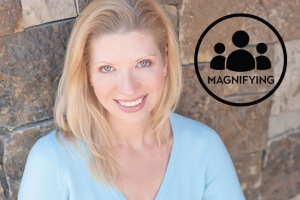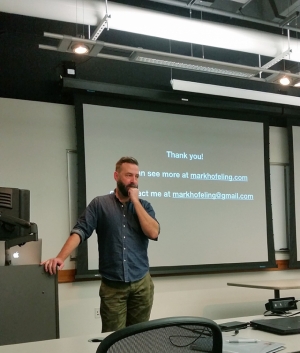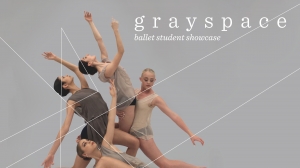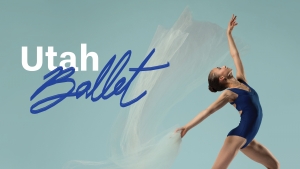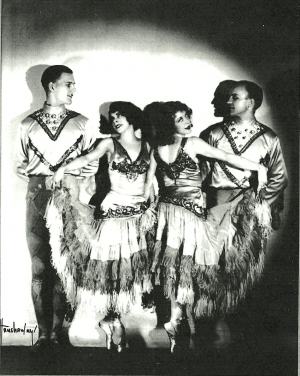Displaying items by tag: Ballet
11 fresh dances presented in MIDDLEGROUND
By Brooke Elizabeth Wertwijn
The School of Dance students present a wide range of styles, voices, and stories in MIDDLEGROUND. Within the broad spectrum of eclectic works, eleven choreographers have put together a cohesive show with something for everyone. While some students have had experience choreographing before, for many, this is their first time presenting their work on the stage. As these young artists move from the role of dancer to choreographer, their choreographic voices offer insights into the subject matters that inspire them to speak through dance.
Juliana Godlewski, a senior in the ballet program, found inspiration for her piece, entitled “Pointe ‘n Boogie,”in classic disco movies and footage of disco competitions she found online. Godlewski describes her movement vocabulary as having “a contemporary ballet base with a variety of disco funk influences.” Set to music by Donna Summers, the Bee Gees, and Hot Chocolate, the dancers seem to have stepped right out of Saturday Night Fever. She continues, "I wanted to channel a night out at the disco...sequins, sweat, killer dance moves, glitter, vogueing, mascara streaming down your cheeks at 2 am, the Bee Gees... this is Pointe ‘n Boogie." Godlewksi’s choreography will make you want to jump out of your seat and start grooving with the dancers.
Many choreographers investigate their own curiosities about life through their choreographic process. Sydney May’s new work, “The Matter of Time,” is a deep, personal study on our relationship to time. She describes the central idea of her piece as an exploration of the “paralytic polarization of the past and future that results in the suppressed progression as a part of the human condition.” This complex idea is artfully embodied in May’s choreography by her three dancers. Each dancer’s individually distinct movement vocabulary push and pull on one another creating a sense of tension between our past and future selves. Her work invites the audience to consider their own relationship with the passing of time and reminds us to appreciate the present.
Geneviève Basu researches the frustrations that come with not feeling safe “to use our own voice to stand up for ourselves out of fear.” Basu’s raw and rhythmic choreography displays the juxtaposition between group pressures and individual conflicts when you keep quiet despite how you feel. This piece conveys an intensity of emotions that will resonate with the audience.
Alexa Knutzen’s work, “A Mere Distraction,” touches on the struggles humans face to be authentic and real. Knutzen explores how “we tend to fill our lives with distractions to delude our emotions” through intricate choreography set to the haunting song “Send in the Clowns.” This is her second time choreographing at the School of Dance. She says she has not only experienced tremendous growth in her choreography, but also is grateful for the opportunity to collaborate with a group of talented dancers and choreographers to put on this performance.
These four choreographers are just a sliver of the immense talent included in the School of Dance’s MIDDLEGROUND. This performance will be an opportunity to witness and experience the dynamic variety of voices from young artists within Salt Lake City’s community.
Join us for MIDDLEGROUND, November 21 at 5:30pm, November 22 at 7:30pm, and November 23 at 2 and 7:30pm.
This show is free and open to the public.
Author Brooke Wertwijn is a Ballet major in her junior year.
by Molly Powers
Ballet students from America and Korea gathered in Incheon, Korea in August for three weeks of rigorous ballet training and rehearsal in the state-of-the Art University of Utah Asia Campus studios. The International Ballet Summer Intensive, or IBSI, provides a unique opportunity for U of U students to pair high caliber training with travel and cultural exchange. School of Dance Professor Jay Kim created this program with a focus in Russian Vaganova ballet training and gathered a faculty whose careers span the globe in prestigious companies including Kirov/Mariinsky Theatre, Royal Swedish Ballet, Dutch National Ballet, Norwegian National Ballet, Zurich Ballet, National Ballet of Spain, Universal Ballet, Boston Ballet, and Tulsa Ballet Theatre. IBSI Directors Jay Kim and Oleg Vinogradov were joined by renowned international faculty Sasha Lunev, Dragos Mihalcea, Seh Yun Kim, Victoria Stocki, and Michelle Armstrong.
The program came to a close on August 16 with a Gala performance that was attended by 1,600 Korean ballet fans. The evening highlighted the skills developed by students over the course of the Intensive, and included roles in variations, excerpts, and character dances from the classical ballets of Don Quixote, Swan Lake, Le Corsaire, and Paquita. Professor and IBSI General Director Jay Kim served as Master of Ceremony of the performance along with Oleg Vinogradov, former 23-year Artistic Director of the Mariinsky Theatre in Saint Petersburg Russia, and three Korean national government representatives who enthusiastically spoke as key note speakers in support of the ballet event. The program also included a special performance by the fabulous breaking fusion dance crew “Heima”, who were Finalists on NBC’s World of Dance season 3.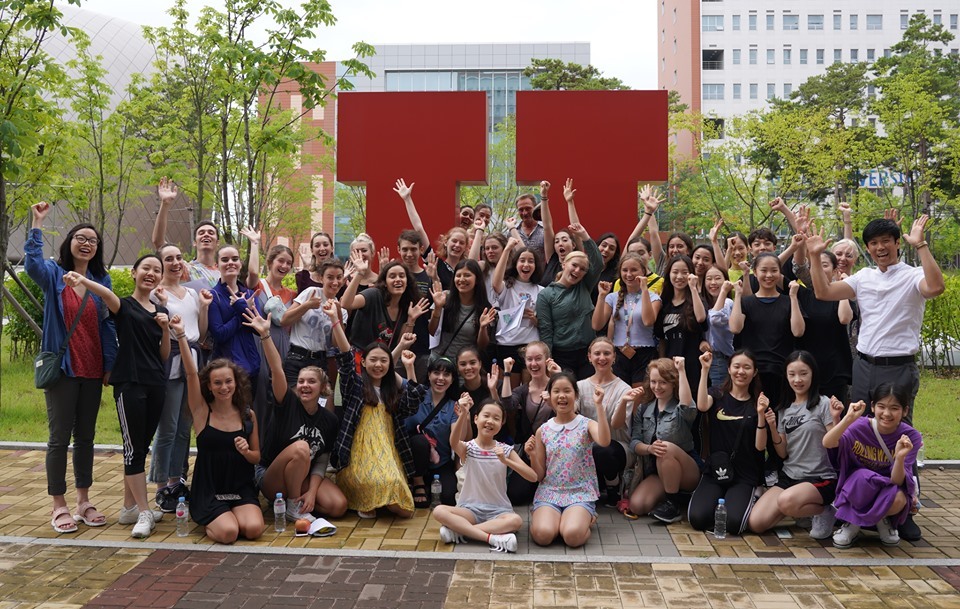 IBSI students and faculty on their Incheon Global Campus tour
IBSI students and faculty on their Incheon Global Campus tour
Incoming U of U Freshman Megan Lynch is a double major in ballet and history, and was one of IBSI participants. When she was invited to attend the program she said she could not let the opportunity to study ballet abroad pass her by. “I enjoyed the diverse group of dancers,” she explained. “We had fun cultural exchanges happening every day inside and outside of class.” Days were filled with enriching training, says Lynch. “We started each day with a bit of conditioning before technique class, followed usually by Pointe, Variations or Men’s class, a lunch break, and then Gala rehearsal.”
IBSI is not all work and no play; outside of the studio, students got the chance to visit Incheon and Seoul and enjoy Korean culture, history, fashion and cuisine. “Almost every night we are able to explore, and each Sunday we went to Seoul. Some of the most memorable places I have been to are Chintatown and the Sinpo International Market."
With the successful completion of the first summer of IBSI, Director Jay Kim is looking forward to the future of the program. “The Incheon, campus, and ballet communities were generous in their excitement and praise of the IBSI program and Gala acclaiming it as comparable to a professional company. It is very rewarding that success came to fruition after this past year of preparation and hard work in creating this program,” said Kim. “The fabulous facility, wonderful leadership, faculty, and training, combined with talented American and Korean students, within a culturally enriching environment, resulted in a very unique and high caliber educational experience. IBSI student feedback was overwhelmingly positive, expressing that it was an unforgettably enriching experience in their lives and ballet careers. We hope to continue to expand the program to many other countries in the future.”
For more info about IBSI, visit dance.utah.ed/ibsi
The University of Utah Ballet Program proudly presents La Fille Mal Gardée, a full-length comedic ballet gracing the Marriott Center for Dance Stage. Based on a 1789 French ballet the School of Dance will present a new interpretation by Bruce Marks, with staging by Mercyhurst University Professors Tauna Hunter and Michael Gleason. This dynamic adaptation breathes new life into the classic story.
La Fille Mal Gardée or the “Poorly Guarded Girl,” will transport audiences to an idyllic pastoral countryside where a love triangle creates comic chaos. In this romantic comedy, Lise, the only daughter of the overbearing Mother Simone, attempts to free herself from a marriage with her uninterested fiancé, in order to be with her true love Colas. The engaging and lighthearted storyline is propelled by the mischievous antics of the cast as they hilariously navigate the ballet’s three acts. This up-beat production features a lively succession of scenes of gossiping villagers, maypoles, and hay wagons, all paired with Marks’ intricate and challenging choreography.
“It’s been an amazing experience to have Bruce Marks here working with our students. He is warm and generous, and giving, of his time and his knowledge,” said ballet Program Head Melissa Bobick. “The students have really grown in their confidence, having the opportunity to work with him.”
Bruce Marks received his performing arts training at the New York High School of Performing Arts, Brandeis University and The Juilliard School. In 1956 he joined the corps de ballet of the Metropolitan Opera Ballet and in 1958 became premier danseur. Marks joined American Ballet Theatre in 1961, soon being promoted to principal dancer. In 1971 he became the first American principal dancer with the Royal Danish Ballet where he remained for five years. By 1976 Marks became Co-Artistic Director of Ballet West at the invitation of its founder Willam Christensen and in 1978 became the prestigious company’s Artistic Director. In 1985 Bruce Marks assumed the position of artistic director of Boston Ballet, a position he held until 1997. A founding member of Dance/USA, Marks was chosen in 1989 to replace the late Robert Joffrey as chairman of the International Jury of the USA International Ballet Competition, a position he still holds. He has created of thirty original ballets over the course of his career. He has coached and staged ballets for companies like the American Ballet Theatre, Royal Danish Ballet, National Ballet of Canada, and many others.Join the School of Dance for La Fille Mal Gardée, February 2/7 – 2/16 at the Marriott Center for Dance at the University of Utah. Tickets are available online, by phone at 801.581.7100 and at the door 30 minutes prior to curtain. For more information please visit here.
by guest blogger Syndey Joy.
From the School of Dance emerges a bevy of new voices. Burgeoning student choreographers share with the Salt Lake City dance community a performance entitled XI: eleven perspectives on dance, showcasing not only their flourishing choreographic skills but also a vulnerable glimpse inside the minds and experiences of young artists. Many of the pieces focus on the idea of resilience, and the ways in which everyone moves through life. The eleven contributions are both the students’ interpretations of the human experience and an expression of who they are as choreographers and artists. Whether exploring concepts of gathering strength through community, finding pure joy in music and movement, or growing through the process of loss and acceptance, each new work is honest and sincere. These impassioned young artists show immense promise as they navigate the transitions from dancer to choreographer, follower to leader.
Each piece in the program differs from the others simply because of the choreographers’ expansion upon their individual voices. From start to finish their unique processes shape and mold the work they create. For choreographer and junior, Alexa Knutzen, her initial inspiration came from the beloved children’s book, The Giving Tree. While her piece may not follow the storyline that Shel Silverstein laid out, Knutzen says it is about how, “as human beings we tend to spread ourselves a little too thin.” Just as the namesake tree finds itself feeling empty, small, worthless, and ultimately lost, we can also find ourselves in the same situation. Her piece, “Lost Yet Found,” explores those parallels as well as the concept that “once we are pushed to our breaking point, it is then where we can start to build ourselves up from the bottom up.”
Many choreographers often find inspiration within music, including senior Madeline Driver. Her new work, “Groove,” began just as it sounds. “I have to find music that invites me to move before I even think about creating a new work,” says Driver, adding that her process has majorly been focused on “diving into the fascinating culture of 1940s America and learning other ways to look at the many purposes of dance.” With lively swing music and an actual record player on stage, Driver and her dancers invite us all to remember the power that social dance had on the communities of that era. This core value has not informed the formation of her choreography but also how she works with her dancers, not only building a community in the performance but in real life as well. Driver’s focus on keeping the movement natural and instinctual allows the dancers to inflect their own voices and personality to the piece, bringing them into the choreographic process and adding authenticity to the display of social dance.
Fellow choreographer and senior, Brendan Rupp, also played with the idea of a community, but rather where we all fit in a community. Within his process he played with “the way a person has to navigate life to continually find the mythical “place” they belong, whether that means meeting somebody else, going off on your own for awhile, or perhaps sticking with a group of like minded people.” He incorporated these ideas into his choreography by also working with his dancers to find a natural fit between the movement, music, and individual bodies. His piece “wander/wonder” plays with the notion of whether or not the grass is always greener on the other side, and as Rupp noted, “sometimes it really is.”
These three exciting new works are simply a glimpse of the culmination of emerging ideas, voices, and choreographers presented in XI. This performance is not only a chance for the audience to experience the revelations of young artists, but also a thrilling opportunity for those artists to push beyond familiarity and share a vulnerability with each other and the audience.
XI: eleven perspectives on dance runs 11/29, 11/30, and 12/1 at the Marriott Center for Dance at the University of Utah. Tickets are available online, by phone at 801.581.7100 or at the door 30 minutes prior to curtain. For more information please visit here.
Like mother, like daughter: Ballet senior learns Arpino solo from original dancer, her mother
Brooke Huebner is a Senior Ballet Major in the School of Dance and recently had her final performance on the Marriott Center for Dance Stage. The senior show is historically packed with emotion, as the class bids adieu to beloved faculty and classmates, but Brooke’s performance added an extra layer of meaning to the evening. Huebner was given the rights to a variation of “Italian Suite” by choreographer Gerald Arpino, whose muse for this neoclassic solo was Huebner’s mother, Elizabeth Molak-Huebner. Huebner will be learning the piece from her mom, who danced with Arpino throughout her career.
“My mom received a full scholarship to the Joffrey Ballet School in NYC at the age of 14. Trained for 2 years and then was accepted into Joffrey 2 at 16 and was promoted into the main company at 18. She immediately was called into private rehearsals with Mr. Arpino and roles were created for her in ballets (Jamboree, Italian Suite, Quarter Tones for Mr. B -honoring George Balanchine after his passing, etc.)”
Brooke attributes her love for dance to her mother, who continues to teach at her studio in California.
“My mom raised me and my sisters at the studio, we basically lived there, so being able to watch her dance everyday made me want to be just like her when I was older. Still to this day my mom teaches ballet and demonstrates combinations fully, sometimes even with pointe shoes. She is so inspiring to me.”
The Gerald Arpino Trust gave Brooke the rights to “Italian Suite” as a way to honor the 10thAnniversary of Arpino’s death. Elizabeth remembers working with Arpino fondly. "Mr. Arpino brought out your best features, he was positive, nurturing and collaborated with the dancer for the choreography, it was a partnership that was inspiring and magical," she recalls.
Learning the solo has created a new opportunity for Brooke and Elizabeth to bond as well. “My mom has taught me everything I know about ballet/dance, and I have worked with her my whole life, but this is a very different experience for sure. Being able to learn this special piece from her, all the nuances in the choreography, and even some of the commentary Mr. Arpino would say in rehearsals has been such a surreal experience. Of course, since she is my mom she pushes me harder because she knows what I am capable of, but this is I think the coolest thing that we have worked on together. It also calls for some extra mother/daughter bonding time”.
Take a look at Huebner's and the 2018 Senior class performances below.
{vimeo}266150071{/vimeo}
MAGNIFYING, No. 9: Melonie Buchanan Murray
by Noelle Sharp
For this episode of MAGNIFYING we spoke with Associate Professor, Ballet Program Coordinator and Director of Graduate Studies in the School of Dance Melonie Buchanan Murray. Our creative community here at the College of Fine Arts is diverse and wide spread. With the goal of gaining a deeper knowledge and awareness of the people within our community, we bring you MAGNIFYING, a series dedicated to showcasing the talent of our students, faculty, and staff.
Tell us about yourself: Name, where you are from, what you do and how you got into in your field of work.
Melonie Buchanan Murray. I grew up in Texas, and have lived in Kansas, California, Colorado, and now Utah. I started taking formal dance lessons (ballet, tap, and jazz) at the age of seven and just never stopped! I remember feeling incredibly excited when I realized that I could study dance in college. So, I pursued a bachelor’s degree earning a BFA in Ballet. I then danced professionally for several years working in many genres-- a ballet company, a modern dance company, cruise ships, musicals, and I was even was a Radio City Rockette. I always had a passion for dance in higher education, so after my performance career, I attended graduate school at the University of California, Irvine where I deepened my understanding of, and connection to, dance. From there, I was hired as a faculty member at Colorado Mesa University where I directed the dance program for nine years. Given my addiction to being a life-long student, I began pursuing a doctoral degree in dance in 2012 and will defend my dissertation this Spring. Currently, I am an Associate Professor of Dance and the Ballet Program Coordinator within the School of Dance at the University of Utah.
What has surprised you the most in your life?
This is an interesting question, and I have two answers. Firstly, in a peculiar way, I think my life and career journey have been full of surprises. I never could have imagined some of the adventures I was afforded or the opportunities that suddenly presented themselves. When I was younger, I never envisioned a concrete life-plan or set of expectations about what my career and life would be. In all honestly, I still don’t. I often feel that I still don’t know what I want to be when I grow up! 2) I am consistently amazed by the human capacity for goodness and compassion. Despite the doom and despair that bombards us in the media (and I am not saying that awful things are not occurring, for they most certainly are), humans have the capacity for incredible warmth and generosity of spirit that we can all strive to nurture in ourselves and others.
What do you wish you had known/been told?
I wish I had realized sooner that the world is small and life is short. I see in my students now the fear, hesitancy, and trepidation that I felt as a young artist, and I try to encourage them to go for it, take a leap of faith. I often say to students (and also to myself): “What do you have to lose?”
By School of Dance Assistant Professor Kate Mattingly
“Everything in a room is designed for the actors’ bodies and for the choreography,” said Mark Hofeling, a production designer who has designed over 50 films and television shows, including the High School Musical series and Teen Beach Movie. Hofeling came to the U to talk to the ballet history students early in the morning on November 13th, and his lecture spanned from battling loneliness as a child to working closely with director Kenny Ortegafor a decade.
After his talk, the ballet students had a chance to ask Hofeling about his career and also to view and analyze recent film projects by Justin Peck (The Times Are Racing) and William Forsythe (Alignigung). Hofeling’s insights into the filming techniques (and costs!) were eye-opening. Students’ questions spanned from “does it help to have a camera-man who understands dance?” to “did you get a lucky break?” The answer to both questions was “Yes!”.
Hofeling grew up in Salt Lake City and attended the U briefly before embarking on his film career at age 19. One of his first jobs was building a Mickey Mouse out of snow for a Disney Ice Palace. Soon (about a decade later) his duties expanded to designing over 20 Disney Channel Original Movies, including the three most watched cable movies of all time: High School Musical 2 (2007), Wizard's of Waverly Place, the Movie (2009), and Teen Beach Movie(2013).
As Hofeling explained during his lecture, one of the advantages of filming dance scenes in musicals is that the shots include groups of 10 to 20 people so audiences can see his entire design for a room (floor to ceiling). In films that aren’t musicals, shots typically include close-ups of 2 or 3 people, making much of the rooms they inhabit invisible.
When we watched examples of recent films made by choreographers, even Forsythe’s Alignigung which appears to have “no set,” Hofeling showed how each project has to be carefully designed using lights and camera angles. In the case of Alignigung, there’s special attention to how to obliterate shadows and create the feeling of two dancers suspended in an endless void. Students noticed the ways that filming techniques can increase intimacy and provide a more detailed experience for a viewer. Film projects also hold the potential of making dancing available to people who may never go to a ballet performance. Hofeling revealed that after High School Musical opened, enrollment in dance classes across the country skyrocketed.
For Hofeling, film has been both an outlet––a way to engage his intense intelligence and imagination––and a respite––a way to escape a brutal childhood and a family who did not accept him. Hofeling told the class about seeing the Millennium Falcon inStar Wars in 1977 and discovering an alternate universe where anything seemed possible. Asked if he thinks movies hold the same potential today, especially in a world where destruction and violence are rampant, Hofeling answered “Yes” unequivocally. “I wouldn’t be here if it wasn’t for movies,” he explained. Those two hours in a theater were his way of escaping the abuses of his family and envisioning a better world. As audiences of his films today, we are the lucky ones who get to immerse ourselves in his brilliant and captivating designs.
(This story was originally posted on the School of Dance website)
Written by the School of Dance Ballet Choreography and Production Students
Seventeen Ballet Program choreographers will showcase their original works November 16 through 18, at the Marriott Center for Dance. This performance is the culmination of the Choreography & Production class, and includes pieces ranging from ballet to hip-hop. Although each work is unique, they explore common ideas such as harmonious diversity, the growth of identity, and the gray spaces between binaries.
Many of the choreographers were drawn to the idea of individuality and the way that every person fits together peacefully. Tyler Piwowarczyk’s piece highlights each dancer’s unique strengths. He drew inspiration from the strong women surrounding him and from Coco Chanel’s quote, “In order to be irreplaceable, one must always be different.”
Sierra Govett drew inspiration from a Danish TV advertisement, and her choreography communicates the importance of recognizing the commonalities between individuals. Through a duet, Emily Chapman explores how “the acceptance of vulnerability allows us to connect with others.” Also exploring relationships is Natalie Dellutri, who invites her audience to discover that although an individual may feel lonely, he or she is never truly alone.
The choreographers were also interested in the concept of identity. Tia Sandman’s work explores the concept of “meshing multiple sides of you, into you.” While Madeline Jones uses her choreography to consider that all emotions must be present for an individual to be truly whole. Victoria Coleman reminds her audience that even though they are pulled in many directions, they must stay true to themselves. Emily Lowe’s piece for a solo artist investigates the confident feeling of “I am enough”.
Other choreographers explored the healing power of dance. Brooke Huebner encourages the audience to consider the importance of living in the now, rather than struggling with the burdens of the past and the pressures of the future. Savanna Hunter examines how distance from trauma affects time. In a classical piece, Kyle Cunningham emphasizes the happiness dancers feel when they are dancing for the sake of dancing. Jennifer Dzuranin, inspired by Shel Silverstein’s poems, creates movement hearkening back to a time of imagination. Tori Holmes choreographed in order to remind her audience that there is always hope in the face of oppression, using dance to depict the strength one must have to keep faith. Nell Josephine’s piece investigates the way three people use dance to overcome their anxiety and fear.
Lastly, choreographers explore the gray areas between hard and fast rules. The butterfly effect, in which one tiny action can cause an enormous effect, is the inspiration for Alex Sprague’s work. Lexie Cheyne questions the conventional gender roles found in most dance forms, deconstructing the preconceived notions of what is possible for every individual. Jalen Williams incorporates elements from ballet, contemporary, and hip-hop, declaring, “we are more than just ballet dancers”.
These seventeen choreographers invite you to grayspace at the Marriott Center for Dance, November 16 at 5:30P, November 17 at 7:30P and November 18 at 2P and 7:30P. Tickets are available online, phone at 801.581.7100 or at the door 30 minutes prior to curtain. For more information, please visit Dance.utah.edu.
Utah Ballet Offers Original Works and Classic Favorites
By Molly Powers
On Nov. 2-11, the School of Dance will present the Fall Utah Ballet Performance at the Marriott Center for Dance, showcasing a wide variety of styles, from classic favorites to works created in 2017. The performance will feature original choreography from School of Dance faculty member Melissa Bobick, School of Dance Director Luc Vanier, and guest artist Roderick George, along with a performance of August Bournonville’s classic “Konservatoriet,” staged by Jeff Rogers.
In her work “135,” Bobick explores a raw and visceral quality of movement inspired by the emotions present in life’s most chaotic and unexpected moments. Caught in this unfamiliar place, between the past and the future, the dance holds onto a turbulent present that can only be eased by the fleeting glimmer of hope.
Vanier will present his original piece, “Women if Possible.” He describes his process for the piece here:
“’Women if Possible’ was first created in 1991 in honor of Judy Shoaff-Reading, who was my one of my long-time dance partners at Ohio Ballet,” says Vanier. “My original wish was to push the dancers to use their pointe shoes in novel ways. I later redid the work in 2006 as a duet and again in 2007 for six students at the University of Wisconsin-Milwaukee, where the work became about empowerment as I encouraged dancers to transition from the mind of a student who is always looking to please and do things ‘right,’ to the approach of an artist who ‘owns’ the work.”
The program also features an original work by guest choreographer Roderick George, entitled “F.E.M. Queen.” George compares the movement of the dancers in this piece to the movement of a “pack of wolves.” “F.E.M. Queen” focuses on the ideal of “the feminist” and how that ideal is interpreted by the performers. The title of the work draws inspiration from the game of chess and the capabilities of the chess pieces. “I wanted to think about empowering the women and how to instill these thoughts in the choreography” says George “In chess, the Queen is able to do all the moves that each piece on the chess board can do and is the most deadly.”
The concert will also include the classic masterwork, “Konservatoriet,” staged by Ballet West’s Jeff Rogers. “Konservatoriet” is a two-act vaudeville ballet created by the Danish choreographer and ballet master August Bournonville in 1849 for the Royal Danish Ballet. Set in a dance studio at the Conservatoire de Paris, the first act is a recreation of a Vestris dance class of the exact type attended by Bournonville during his Paris sojourn in the 1820s. In the second act, Monsieur Dufour, an inspecteur at the Conservatoire, writes a matrimonial advertisement in the newspaper but ends up marrying his housekeeper, Mademoiselle Bonjour. Typical of Bournonville’s ballets, the plot provides opportunities for introducing different dance divertissements. In the second act, for example, the pupils of the Conservatoire make a fool of Monsieur Dufour by disguising themselves as attractive women.
Tickets are available online, by phone at 801.581.7100 or at the door 30 minutes prior to curtain. For more information please visit Dance.utah.edu.
The U Has one of the Oldest University Ballet Programs in the U.S.
The U has been offering a ballet major since 1951 and was one of the first university ballet programs in the U.S., according to former Ballet Department chairwoman, Barbara Hamblin. Professor Hamblin was a ballet major at the U herself in 1958, and after an illustrious dance career, returned to teach, and eventually became chairwoman in 1988. Hamblin’s first experience dancing in Salt Lake City was as a high schooler. She took ballet lessons one summer through a Division of Continuing Education Program, where she first met Willam Christenson. No account of the U’s Ballet History is complete without mention of the Christenson Brothers, and especially Willam Christenson.
Originally from Utah, the Christenson Brothers performed extensively in New York City, on the Vaudeville Circuit, and formed the San Francisco Ballet Company in the 1940s. Later, Willam relocated back to Salt Lake City, and successfully founded the University Ballet Department in 1951 at the U. He created the performing group known as University Theatre Ballet, which later became the Utah Civic Ballet – the first iteration of what is now Ballet West.
Hamblin says Christenson had a profound influence on her dance career and her decision to attend the U’s Ballet Program. “His wonderful enthusiasm for ballet and his gregarious personality and sense of humor captivated me, and it was then that I decided to attend the U of U”
It’s not surprising that the first University to offer ballet as a major was in Utah. “Salt Lake City, Ogden, and Provo, always had a very active arts scene I believe partly due to Mormon cultural attitudes” says Hamblin. “Instead of thinking the arts were suspect, the L.D.S. Church celebrated music and dance as a way to communicate joy, hope and for celebration. I think social dances and music were important to Mormon pioneers. Also, most mothers all over the state wanted their daughters to study ballet in order to improve posture and to teach grace and good decorum.” Still, some did not see a university education as compatible with a dance career. Many young dancers considered education a waste of time that did not serve the goal of dancing professionally. Hamblin feels differently. “I’m sure coming to the U was the best choice I could make. There is a lot to be said about the necessity to develop yourself not only as a performing artist but also as a more complete human being through studies available in college. Additional courses from dance history to dance psychology and anatomy inform technique and style for a richer experience for both the dancer and the audience.”
The Ballet Program at the U has enjoyed an excellent national and international reputation in the 66 years since its founding. This is due, in part, to the rigorous training and high standards held by the faculty.
Hamblin states: “The freedom to develop the curriculum for ballet majors so that the schedule of training was as intense as that in a professional school was critical. In many university programs, no pointe technique for women was taught or it was only once a week and technique class were only three days weekly instead of five, which is not rigorous enough.”
Over the years, the Department as well as ballet itself have undergone many changes. In 1989, both Ballet and Modern Dance moved into their current home, The Alice Sheets Marriott Center for Dance. Hamblin, while chairwoman, developed an on-line course in Ballet History, which is still a required course for Ballet Majors. Most recently, the Ballet Department and the Modern Dance Department have come together to form the new School of Dance. Ballet has become increasingly competitive, and more is required of dancers these days, says Hamblin. “I’m happy that I was able to dance during the time I did. Now, I probably wouldn’t have a chance to compete due to the ever-increasing difficulty of what dancers are asked to do choreographically. In addition to the classical repertory, now ballet demands that dancers need to extend the range of their acting and dance techniques to include the more contemporary styles of today.”
One constant, though, is ballet dancers themselves, who prove to be organized, committed, and motivated to pursue their dreams. “It takes a lot of resilience and careful planning to be able to cope with the demanding schedules of classwork and performances on a regular basis.” Says Hamblin. “Having to learn long sequences of choreography teaches dancers to think on their feet and develop amazing memorization skills. Most dancers will learn another dancer’s parts in the hope that opportunities to perform these might come available from time to time. I knew both female and male dancers at Ballet West who learned everything: both men’s and women’s parts. Dancers also learn to anticipate frequent changes and deal with them positively and creatively.”

